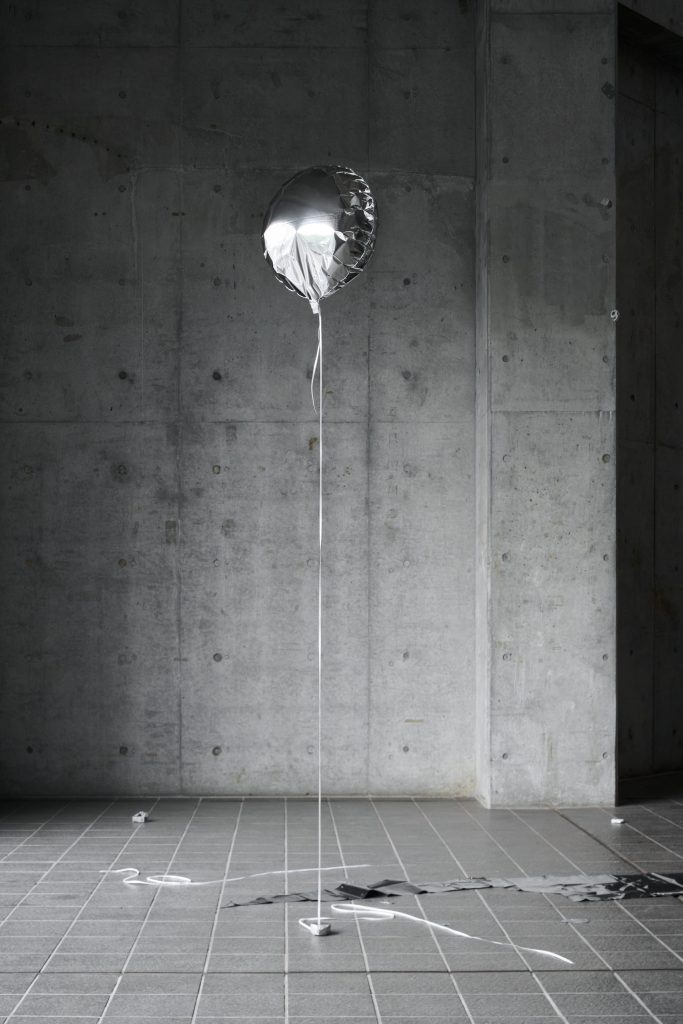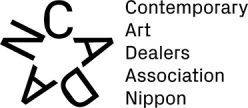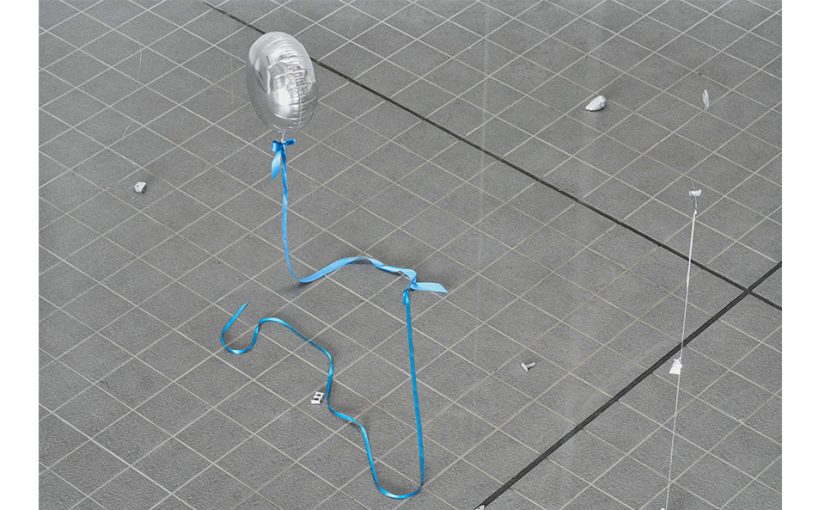Top image: Lateral Thinking 2021 ,Aluminium,helium,ribbon,dimensions variable photo Hayato Wakabayashi
2024.6. 25 Tue – 7.14 Sun
Venue: CADAN YURAKUCHO, Space L
Address: 1F Kokusai Building, 3-1-1 Marunouchi, Chiyoda-ku, Tokyo
Opening hours: Tue-Fri 11-19pm, Sat, Sun, national holidays 11-17pm
Closed: Mon (or the following weekday if the Monday is a public holiday)
Reception Party: 2024. 6. 25 17:00-19:00
Space M: Takuya Ikezaki “ SEA MAP: Receive and Release” by Satoko Oe Contemporary
Space S: Zuzanna Bartoszek ‘Show Room’ curated by Tenko Presents , hosted by KAYOKOYUKI
We are pleased to announce that from June 25th, we will be holding an exhibition titled The Blessed Land of “Kotodama (言霊)”ーThe dream of Amaterasu, Helios and Kāne by Shiho Kagabu at CADAN YURAKUCHO.
Kagabu uses various objects such as broken found items and construction materials to create sculptural works. In her works, the everyday meanings and functions of these objects are dismantled, and through their combination, new relationships are formed and placed within the space. Kagabu, who says, “I doubt the rules defined by humans, but I believe in the earthly and cosmic rules,” approaches objects, listens to the voices they emit, and becomes part of them, constructing the principles of creation and circulation, which can be called the laws of nature, within the exhibition space.
In this exhibition, works made of aluminum and balloons will be displayed, changing shape over time. The title is derived from a phrase in the Manyoshu, “Kotodama no Sakiwau Kuni,” which reflects the artist’s hope to create a rich land that spreads out into the world, much like Japan, which was originally considered a blessed land filled with the power of beautiful words and kotodama (the spirit of words). The subtitle references deities associated with the sun in the Kojiki, Greek mythology, and Hawaiian mythology.In her works, Kagabu places great importance on balance. Triggered by the Great East Japan Earthquake on 3/11, she has heightened her awareness of natural disasters such as earthquakes and, through her experiences of childbirth and child-rearing, she has deepened her recognition of the body as a part of nature, including its sexuality. In addition to her long-standing interest in “time” and “change,” she has been exploring the earth through comparative mythology and the commonalities of landforms. Over the past decade, she has been engaging in this exploration through daily activities such as cooking, walking, traveling, and living. Kagabu has physically visited volcanic regions like the seas and mountains of Japan, Italy, Hawaii, and recently, the Greek islands of Crete and Santorini. By walking, swimming, and tasting local fruits, she experiences the differences in water, climate, terrain, and culture, reflecting on time and occasionally feeling the effectiveness of images and narratives. While considering the creation of her sculptural works, she seeks a common language with various objects, environmental changes, and physical conditions.
The Blessed Land of “Kotodama (言霊)”
ーThe dream of Amaterasu, Helios and Kāne
Splash of Sunlight
The brilliance of sunlight falling between the waves of the clear sea, water drawn up from the soil forming clumps of droplets on the underside of leaves,
shadows sinking into the asphalt and dust clouds covering the field of view.
Borrowing the wisdom of Daedalus, Ariadne abandoned her home to help Theseus escape, only to be left behind and abandoned on an island once she was no longer needed. Daedalus and the fate of his son Icarus, who escaped with solidified wings.
From various climates and landscapes on Earth, myths and folktales with common themes have been passed down through the ages in different regions.
Many gods of war, gods who govern wisdom and technology, and icons of flora and fauna. Gratitude for the blessings of nature and offerings and festivals to ward off threats.
The behavior of selfish gods, who push forward driven by desires, often disregarding moral consciousness, can sometimes inspire a sense of breaking free from the constraints felt by modern people. They offer hints for laughter and thought for now and the future.
I often contemplate the existence of Kotodama (the spirit of words). Words written, spoken, and cast as wishes and prayers,
are not meant to function as tools but as something with substance.When calling someone’s name, it is spoken carefully and sent forth with care.
In most cases, even if the appropriate words come to mind, they cannot be conveyed effectively to the other party (not limited to humans) right away.
Due to the heat and time emitted from both sides and the waveforms of color, it is difficult to articulate properly.
Besides conversations that resemble soliloquies, the words fall and solidify on the ground.
Sometimes, a beautiful favorite song comes to mind, calming the heart, not for anyone in particular,
and is sung as a delicate prayer, but in joy of the beauty of light.
By witnessing and experiencing the here and now through small, simple methods, while touching and moving various things through the physical limitations of bending of wings, I feel that this moment, this reality, that holds the meaning of creation.
Seeing, touching, singing, and praying.
May the fading soul not turn into anger, but rather light a fire and rise as a source of energy. Just like feeling the buoyancy and gravity by wading through the waves with fingers and hands, or observing by throwing pebbles at rocks, one considers the dynamics and atmosphere of the Earth and engages in exchanges about existence within the universe.
A land overflowing with the spirit of words spreads,
and humanity, having made choices for life as a species, can they burn with the awareness of their finite lives?
Shiho Kagabu
5/14/2024
———
“The Land Blessed by the Spirit of Words”
*Manyoshu* (Volume 5-894) by Yamanoue no Okura
“The country of Yamato on the island of Shiki is a land where the spirit of words aids. May you be blessed.”
“This land of Japan is a country where the soul of words helps people. I hope you remain safe.”
*Manyoshu* (Volume 13-3254) by Kakinomoto no Hitomaro
———
Shiho Kagabu was born in 1981 in Kanagawa, Japan, and currently lives and works in Tokyo. She received her B.F.A.in Art and Design from Bunka Women’s University and her M.F.A. in Sculpture from Tama Art University. Shiho also received a Japanese Government Oversea Research Program Grant from the Agency for Cultural Affairs and resided in Milan, Italy from 2017 to 2018.
Shiho has presented her work in: solo show “Lateral thinking -I dream that I fly in the sky. The stars, the tears, do not flow.” at Sculpture Gallery of Tama Art University, Tokyo, 2021; “DOMANI: The Art of Tomorrow 2021” at The National Art Center,Tokyo, 2021; “Made in Fuchu 20 years of open studio production” at Fuchu Art Museum, Tokyo, 2020; solo show ”Mantle Plume -The Anger of Izanami and Pele” at KAYOKOYUKI, Tokyo, 2019; solo show “Dipende” at Tempio del Futuro Perduto, Milan, Italy, 2018; solo show “Critical Point” at gallery21yo-j, Tokyo, 2017; “Tokorozawa Biennial of Contemporary Art “railroad siding 2015” in Saitama, 2015; “KAKEHASHI Project” at Japan Society, New York, 2014; “Artist File 2013:The NACT Annual Show of Contemporary Art” at The National Art Center, Tokyo, 2013; “TAMAgawa tatta hi” at JIKKA and NADiff window gallery, Tokyo, 2013; ”Signals//Itabashi//2011 Live the landscape” at Itabashi ArtMuseum, Tokyo, 2011; “VOCA2010” at The Ueno Royal Museum, Tokyo, “Open Studio Program No.51” at Fuchu Art Museum, Tokyo, 2010; and “back to the drawing board” at geh8 Kunstraum und Ateliers e.V., Dresden, Germany.


